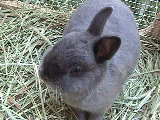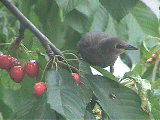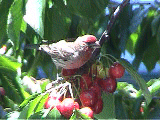 My youngest daughter wants to be a farmer. She is heading off to the local fair grounds tomorrow to help get the barn cleaned up in preparation for the big 4-H show where she will give a presentation on fur mites. Although her rabbit is extremely cute, it usually comes in last place, because cuteness doesn’t count. We indulge her farm fantasies because she is learning a great deal about life and having a wonderful childhood while she’s at it. Childhood only comes around once, at least until you have kids and can partially participate a second or third time.
My youngest daughter wants to be a farmer. She is heading off to the local fair grounds tomorrow to help get the barn cleaned up in preparation for the big 4-H show where she will give a presentation on fur mites. Although her rabbit is extremely cute, it usually comes in last place, because cuteness doesn’t count. We indulge her farm fantasies because she is learning a great deal about life and having a wonderful childhood while she’s at it. Childhood only comes around once, at least until you have kids and can partially participate a second or third time.  She also has four chickens, all of different breeds and hatched from eggs in our basement, the most interesting being the Transylvanian Naked neck. Three of the six chicks that hatched had birth defects. One survived, having a single good eye and a very crooked beak.
She also has four chickens, all of different breeds and hatched from eggs in our basement, the most interesting being the Transylvanian Naked neck. Three of the six chicks that hatched had birth defects. One survived, having a single good eye and a very crooked beak.  The other two were buried in the garden, joining Flippy the ex-toad — lessons in life and death.
The other two were buried in the garden, joining Flippy the ex-toad — lessons in life and death.
In addition to a very modest garden, we have a cherry tree that is amazingly fecund. I thought it would be interesting to try to harvest it at least once. I estimate that the tree grows several hundred dollars worth every year.
 Picking the cherries took a lot of effort, involving many boring hours at the end of precarious ladders. To market them, I set up a stand on the corner and stationed my daughters there. They sold $30 worth in the first few hours before darkness descended. I thought I was on to something but, being city kids, the novelty quickly wore off. They had better things to do the next day than sit in the hot sun waiting for customers to come by. So we tried another scheme: We placed a big bucket of cherries on a table that had a money canister bolted to it with a sign that read “Cherries: 20 cents each (about $2 per pound).” At the end of the day all the cherries were gone and my daughter collected $3 instead of what should have been $30 — lessons in human nature.
Picking the cherries took a lot of effort, involving many boring hours at the end of precarious ladders. To market them, I set up a stand on the corner and stationed my daughters there. They sold $30 worth in the first few hours before darkness descended. I thought I was on to something but, being city kids, the novelty quickly wore off. They had better things to do the next day than sit in the hot sun waiting for customers to come by. So we tried another scheme: We placed a big bucket of cherries on a table that had a money canister bolted to it with a sign that read “Cherries: 20 cents each (about $2 per pound).” At the end of the day all the cherries were gone and my daughter collected $3 instead of what should have been $30 — lessons in human nature.
 I also spent an inordinate amount of time and energy chasing away the plague of starlings that descended on the tree as the cherries ripened. I could clap my hands and send dozens flying at any given time. I have been told that some bonehead introduced them here in the 1940s because he wanted birds around him that had been mentioned in Shakespeare’s plays. They now cause untold crop and ecological damage all across North America.
I also spent an inordinate amount of time and energy chasing away the plague of starlings that descended on the tree as the cherries ripened. I could clap my hands and send dozens flying at any given time. I have been told that some bonehead introduced them here in the 1940s because he wanted birds around him that had been mentioned in Shakespeare’s plays. They now cause untold crop and ecological damage all across North America.
 I do not mind sharing the cherries with the waxwings, woodpeckers, crows, and assorted other birds, but typically, the starlings will eat every last cherry and trying to prevent that was not easy at all.
I do not mind sharing the cherries with the waxwings, woodpeckers, crows, and assorted other birds, but typically, the starlings will eat every last cherry and trying to prevent that was not easy at all.
How successful was my farming experiment? I managed to harvest about a quarter of the crop. The starlings ate the rest. I got about a tenth of my harvest to market. The remaining cherries rotted in buckets or were pitted and dried by my wife and kids. When accounting for labor, those bags of dried cherries are worth a small ransom — lessons in economic realities.
As for the chickens, well, they will someday be worth several hundred dollars a pound, not that we would ever dream of eating them. I am also confident that each egg will cost many dollars to produce as well.
I hope my daughter eventually outgrows her dream of being a farmer before it is too late and we go bankrupt. Few of us have a good feel for what economy of scale can bring. The low cost of food today is not the result of the government-subsidy catchall excuse used for everything we don’t want to believe. It is a result of a free market. Growing your own food can be fun but it would be bad news if we had to do it for real. The concept of buying locally grown food is a compromise that lies somewhere between the indulgent fantasy of growing your own and buying the lowest priced food at your grocery store.
 My youngest daughter wants to be a farmer. She is heading off to the local fair grounds tomorrow to help get the barn cleaned up in preparation for the big 4-H show where she will give a presentation on fur mites. Although her rabbit is extremely cute, it usually comes in last place, because cuteness doesn't count. We indulge her farm fantasies because she is learning a great deal about life and having a wonderful childhood while she's at it. Childhood only comes around once, at least until you have kids and can partially participate a second or third time.
My youngest daughter wants to be a farmer. She is heading off to the local fair grounds tomorrow to help get the barn cleaned up in preparation for the big 4-H show where she will give a presentation on fur mites. Although her rabbit is extremely cute, it usually comes in last place, because cuteness doesn't count. We indulge her farm fantasies because she is learning a great deal about life and having a wonderful childhood while she's at it. Childhood only comes around once, at least until you have kids and can partially participate a second or third time. 
